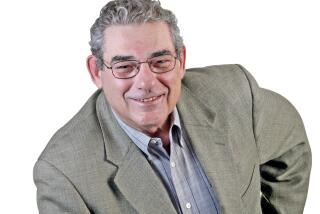‘Gonzo’ Journalist Thompson Kills Self
DENVER — Hunter S. Thompson, the counterculture literary figure who rode with the Hells Angels, famously chronicled the Nixon-McGovern presidential race and coined the term “gonzo journalism,” committed suicide Sunday night at his secluded home outside Aspen, Colo., his son said. Thompson was 67.
“Hunter Thompson took his life with a gunshot to the head at his fortified compound in Woody Creek,” Juan Thompson said in a statement. “Hunter prized his privacy and we ask his friends and admirers to respect that privacy as well as that of his family.”
Pitkin County sheriff’s officials confirmed Sunday that Thompson died of a gunshot wound, saying they received a call from his home about 6 p.m.
Friends and neighbors said late Sunday that they were shocked by Thompson’s suicide, but knew he had his demons.
“We don’t know anything about the circumstances surrounding his death, but he was a volatile person,” said Troy Hooper, associate editor of the Aspen Daily News and a longtime friend of the writer. “I was at his house last week and there was nothing in his behavior that was different. He was no more distraught than usual; he was often either up or down.”
Hooper said Thompson had been in pain from back surgery and an artificial hip. And he had broken his leg on a recent trip to Hawaii.
“He said he was executing a hairpin turn at the minibar when he broke it,” said Hooper, who said he was acting as the family’s spokesman. “Hunter was one of the literary giants of the 20th century. We are all just shocked.”
Thompson, whose works included “Hell’s Angels,” “Fear and Loathing in Las Vegas” and “Fear and Loathing: On the Campaign Trail ‘72,” which chronicled the race between Richard Nixon and George McGovern, was a well-known firearms aficionado who took frequent target practice in his backyard. In 2000, he slightly wounded an assistant while trying to shoot a bear on his property.
Woody Creek, a small town about eight miles northwest of Aspen, is home to a number of celebrities including the TV actor Don Johnson and John Oates of the singing duo Hall and Oates. Thompson spent much of his time socializing at the Woody Creek Tavern.
“We’re letting it rest for tonight,” said a woman who answered the phone Sunday at the tavern, where Thompson ate lunch most days.
Buddy Ortega, 62, a real estate broker and ski instructor, met Thompson in the 1960s at a party. The pair socialized over the years, and Ortega supported Thompson’s quixotic run for sheriff -- though he figured it was a longshot when he saw campaign posters with pictures of hallucinogenic peyote buds.
In recent years, Ortega said, the hard-living journalist had become more reclusive, hanging out at the home he called his “compound” and taking advantage of open space to fire his automatic weapons.
But Ortega hadn’t seen anything out of the ordinary recently. He said he last saw Thompson two days ago at Woody Creek’s post office, and everything seemed fine.
“We all have demons,” Ortega said. “Who knows, man? You sit down, have a few cocktails or maybe nothing -- maybe you have a cup of green tea -- and maybe nothing seems right. He was a little more complex than most of us, so maybe some of those demons surfaced and he didn’t like what he saw.”
Hunter Stockton Thompson was born July 18, 1937, in Louisville, Ky. His father, Jack, was an insurance agent.
In 1963, he married Sandra Dawn, the mother of his son Juan.
He served two years in the Air Force in Florida, where he was a newspaper sports editor. He was the Caribbean correspondent for the New York Herald Tribune in 1959, and worked as a South American correspondent for the New York-based National Observer from 1961 to 1963.
But he earned his outsized reputation for his work in Rolling Stone magazine.
Thompson was the flip side of American novelist Tom Wolfe. Both established themselves as brand names in the literary journalism movement that sought to capture the strife and youthful boldness of the 1960s. Thompson was the wild man who embraced the chaos, while Wolfe was often portrayed as the buttoned-down neutral observer.
Thompson called what he did “gonzo journalism,” differentiating it from mainstream reporting by aggressively injecting himself into the story and giving up any pretense of objectivity.
Thompson’s style of journalism -- well-armed, well-drugged and wildly iconoclastic -- made him a counterculture figure of rare longevity.
“I hate to advocate weird chemicals, alcohol, violence or insanity to anyone ... but they’ve always worked for me,” Thompson said.
His irascible and volatile persona seemed to outsize the books and essays he wrote. Twice his life was brought to the screen -- once by Bill Murray in 1980’s “Where the Buffalo Roam,” and again in the 1998 Terry Gilliam film “Fear and Loathing in Las Vegas,” in which Johnny Depp took his turn as Thompson. Both actors remained friends with Thompson.
Thompson also triumphed on the comics page -- ensuring that the most maverick journalist of his generation could get a spot in the mainstream newspapers that would never dare print his profanity-laced essays. The character of “Uncle” Duke in the “Doonesbury” strip has for decades been a thinly disguised and always mercenary caricature of Thompson.
William McKeen, a University of Florida professor who wrote the 1991 critical biography “Hunter S. Thompson,” kept in touch with the journalist.
“He had clearly been amid a great renaissance in recent years where the public had rediscovered his value and their interest in him,” McKeen said Sunday night. “The news is stunning.”
Times staff writers Samantha Bonar, Geoff Boucher, Megan Garvey, Ashley Powers and Richard Fausset contributed to this report.
More to Read
Sign up for Essential California
The most important California stories and recommendations in your inbox every morning.
You may occasionally receive promotional content from the Los Angeles Times.










